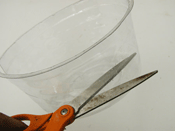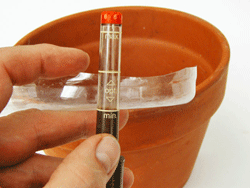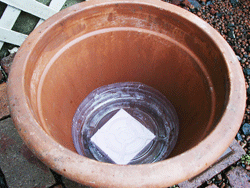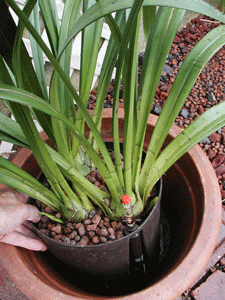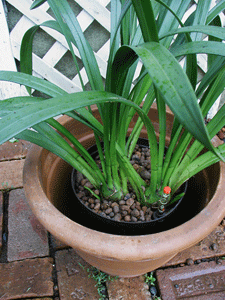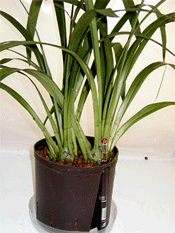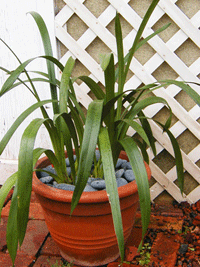

Plant Care for Cymbidium Orchids |
|||||||||||||||
| Cymbidiums
boast some of the most dramatic flowers in the orchid
kingdom. Depending on your climate, plant care for cymbidium orchids
can
vary from easy to somewhat challenging. Cymbidiums are popular in temperate, sub-tropical climates such as California, where they grow outside year round. The warm, sunny days and cool nights (40-55 degrees) found in this area are perfect for these plants. Cymbidiums just aren't suited for growing indoors however. Without lots of daytime sun and cool evening temperatures (40-50 degrees) you'll get good looking plants but they just won't bloom. And isn't that why we grow orchids? |
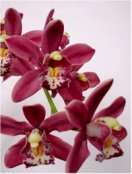 |
||||||||||||||
| In
Northern climates, the best cymbidiums
are usually grown in greenhouses. Don't have a greenhouse? Don't
worry. Even if you're climate challenged, you can still grow
these orchids. Just remember that plant
care is a little different from other orchids. Not difficult,
just
different. How to Grow Cymbidiums 1. In the spring, move your plants outside for the summer where they get several hours of direct sun. 2. Leave them outside until temperatures reach the 40 degree range. ( Cold temps trigger blooms.) After a good dose of cold weather in the fall, bring your plants indoors. 3. You should see flower spikes appear Jan-Feb. Then, enjoy those magnificent blooms - just when you need them. 4. When warm weather returns, move your plants outside for another growing season. Light: Cymbidiums require lots of light. Without proper light you'll see weak growth and no flowers. If you can't move your plant outside during the summer months, these plants are probably not for you. Mature cymbidiums need several hours of direct morning or afternoon sun. Leaves are always a good indicator of proper light. They should be light green with a tinge of yellow - dark green means not enough light and your plants won't bloom. Too much sun and the leaves will turn yellow or bleached white. |
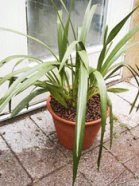 Cymbidium growing outside 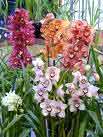 Blooming season for
Cymbidiums is late winter - just when you need it!
|
||||||||||||||
| Temps: The ideal temperature
range for cymbidiums is in the 40-90 degree
range. They don't make good indoor plants
because temperatures
won't be
cool enough at night (and there's not enough sun during the
day.) To initiate blooming, keep your plants outside until temperatures drop into the low 40's. You might even see frost - don't worry - these plants can take it! Damage occurs if temps drop below 30 degrees however. When it's time to come inside, put your plants in sunny window and keep them as cool as possible, preferably around 55 degrees at night. Too warm and the buds will turn yellow and drop off. After flowers open (Jan-Feb), plants don't need the cool temps anymore so display them anywhere for show. Water: Watering for Cymbidiums varies with the season. Outside, your plants will be actively growing so increase the watering. This means watering to 1/4 or 1/2 on gauge. Then waiit until bottom of pot is dry before rewatering. In the fall, when the plants are moved back indoors, cut back on the watering. Water until the gauge moves - then stop! Don't rewater until bottom of pot is dry. In March, after blooms have faded, reduce watering even more. Just run water through the pebbles once a week to keep the plant from dehydrating. Don't allow standing water at the base. Cymbidiums go dormant for a month or two so don't expect new growth. This is the best time for transplanting into larger pots if necessary. It's also the best time to transfer to hydroponics. See Transplanting Cymbidiums into Hydroponics. Nutrition: Nutrition also varies with the season. During their active growing season outside cymbidiums are heavy feeders. Apply nutrients at full strength every watering. Occasional rain showers balance the nutrition program by providing clear water between feedings. We recommend and use Dyna-Gro Grow Formula7-9-5. Every couple of waterings add Dyna-Gro Mag-Pro 2-15-4 to the mix to give the flowering process a boost. When the plants are moved indoors in the fall stop all nutrients! This encourages the bloom cycle to begin. When flower spikes appear, apply Dyna-Gro Bloom Formula. After the last blooms have faded eliminate all nutrients again until plants are moved outside. |
|||||||||||||||
Cymbidiums and Hydroponics Cymbidiums are excellent candidates for our hydroponic system . The LECA pebbles never breakdown or decay, insuring a healthy root system. Because the pebbles are a sterile ceramic, they won't attract insects while your plant is outside. And you never have to repot because the media is deteriorating. The water gauge makes watering easy through the different seasons. Our system is clean and easy to use, both inside and outside. |
 |
||||||||||||||
When growing Cymbidiums outside, adjustments to our hydroponic system are necessary to accomodate the extra water from rain showers (and watering with a garden hose). Normally, the decorative outer container acts as a reservoir, storing the nutrient solution. Outside, frequent rain showers tend to fillup the outer pot, overflowing the system. We replace the outer pot with a shallow saucer that is only 1/2 inch deep. When it rains, excess water overflows the saucer and drains away, keeping the plant from drowning.
|
|||||||||||||||
| Repotting Cymbidium - Transplanting to Hydroponics | |||||||||||||||
